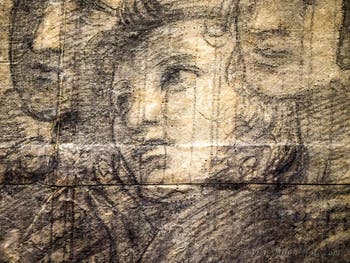Museums Ambrosiana | Castello Sforzesco | Poldi Pezzoli
Ambrosiana Artists | Location | Opening Hours Tickets | Authorizations
Artists Leonardo da Vinci | Botticelli | Raphael | Caravaggio | Titian | Luini | Bassano | Bramantino | Lucretia Borgia | Piazza | Pinturicchio | Tiepolo | Veronese B. | Vivarini
Raphael “Preparatory Cartoon of the Vatican School of Athens” at Ambrosiana Gallery Pinacoteca in Milan in Italy
Raphael (April 6, 1483 - April 6, 1520) “Preparatory Sketch of the Athens School”
Painting - Black and White Ceruse Chalk on Cardboard (285cm x 804 cm) 1509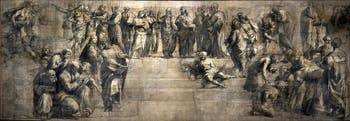
Raphael School of Athens Cartoon The function of the preparatory cartoons was to help reproduce, on the same scale, the outline of the drawing on the wall before painting the frescoes.
The cardboard was used as a matrix, a layer for the performers who followed the lines by piercing it in dotted lines with a needle in order to transfer the drawing onto the wall.
To reproduce the drawing on the preparatory cardboard identically, producing the dotted lines on the receiving wall was sufficient.
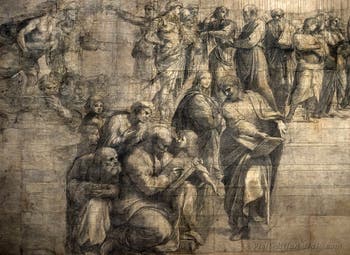
Raphael School of Athens Cartoon At the end of this operation, the master's original drawing was precisely transferred to the wall in full size, down to the smallest detail.
To do this, the holes made in the cardboard were filled with carbon powder, which thus marked a series of black spots on the white lime wall, which was then to be frescoed.
Since the contact of the cardboard with the lime causes the degradation of the cardboard, very few preparatory boxes have reached us.
The fact that the design of the preparatory cardboard of the Athens School is still visible today and even in an excellent state of preservation is remarkable, which allows us to appreciate the seriousness and quality of the creative processes used by Raphael.
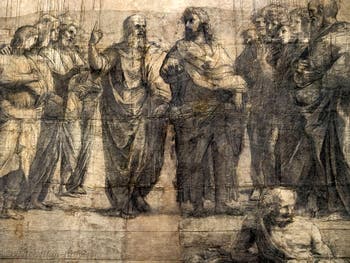
Raphael School of Athens Cartoon But the most surprising thing about this preparatory cartoon of the School of Athens is the precision of the line: no failure, no repetition on the part of Raphael.
This proves that he had achieved great artistic mastery at that time in his life.
Moreover, Raphaël did not content himself in drawing only the outlines of the drawing, as was usually done for preparatory cartoons for frescoes.
Everything was already represented on this cardboard, the shadows, the nuances that anticipate the pictorial effect of the colour, in such a way that the painters responsible for “putting back” the preparatory drawing of the fresco on the wall of the Signature Chamber could not deviate one line from the load assigned to them, the risks of rework being thus greatly minimized.
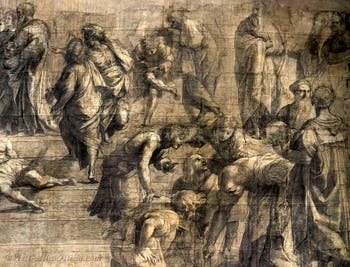
Raphael School of Athens Cartoon The preparatory cardboard for the Ambrosiana School of Athens can be considered a work of art in itself, as it is perfect and expressive.
Comparing this cardboard with the final fresco, we can fully appreciate the precision with which the painted part reproduced the most minor details of the layer: the expressions, the general atmosphere, the movement, and the passion of the characters are, in fact, fully respected.
The Fresco of the School of Athens at the Vatican Museum in Rome.
A level of technical excellence worthy of Raphaël's genius: The expressions, gestures, positions and space management are perfect.
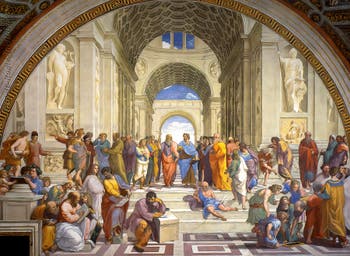
Raphael, School of Athens And yet, the task was far from easy since it was not a question of simply representing different characters but also, above all, of being able to reveal their respective ideas and characters.
Raphaël surpassed this incredible challenge with talent and intelligence: looking at his fresco, everything seems so obvious, so balanced, so lively.
In their respective roles, philosophers have a real presence; we see them passionately concentrated, confronting their ideas and disseminating their knowledge.
These elements elevate “The School of Athens” to the level of a masterpiece.
Artists Leonardo da Vinci | Botticelli | Raphael | Caravaggio | Titian | Luini | Bassano | Bramantino | Lucretia Borgia | Piazza | Pinturicchio | Tiepolo | Veronese B. | Vivarini
Ambrosiana Artists | Location | Opening Hours Tickets | Authorizations
Museums Ambrosiana | Castello Sforzesco | Poldi Pezzoli
Back to Top of Page




















































